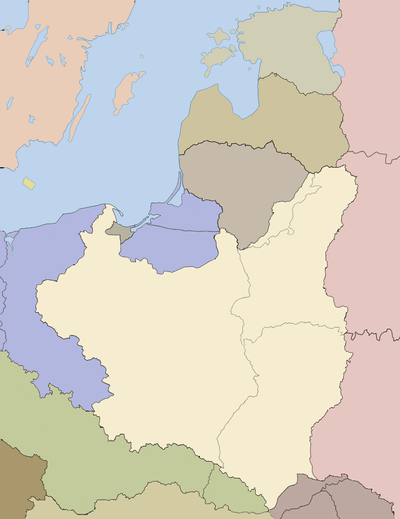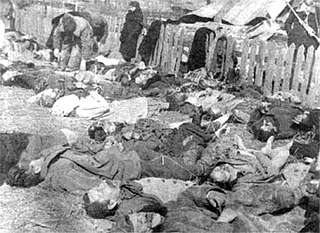Glinciszki massacre
The Glinciszki (Glitiškės) massacre was a mass murder of Polish civilians by the Nazi-subordinated Lithuanian Auxiliary Police Battalion,[1] committed on 20 June 1944 in the village of Glinciszki or Glitiškės (in pre-war Second Polish Republic, war-time Generalbezirk Litauen, post-war Lithuanian SSR, now Lithuania) during World War II. In the massacre, at least 27 civilians were murdered,[2] including 12 women (one in advanced stage of pregnancy), 11 children (as young as 3 years old), and 6 elderly men.[3] They were executed as a collective punishment for the death of four Lithuanian Nazi policemen on the previous evening,[4] during the skirmish with the Polish resistance units of the 5th Brigade of Armia Krajowa commanded by Lieutenant Wiktor Wiącki.[1] In revenge, Armia Krajowa killed 20–27 Lithuanian civilians in Dubingiai massacre two days later.[2][3]
(map of Poland before the 1939 invasion)
Murders in Glinciszki
On 19–20 June 1944, commander of the newly formed 258th Lithuanian Auxiliary Police Battalion received reports of Polish partisans stationing in Glinciszki (Glitiškės) and sent eight scouts to investigate.[5] The scouts ran into the 5th Brigade of Armia Krajowa: four of them were killed, two were injured, and two escaped.[5] According to information published by a bulletin of the Lithuanian Freedom Army, the four dead Lithuanians were injured and later allegedly executed by stabbing with bayonets.[6] According to Paweł Rokicki of Institute of National Remembrance, they died in an exchange of fire, surrounded by soldiers of the 1st company of Lieutenant Wiktor Wiącki ("Rakoczy") and the 3rd squadron of Antoni Rymsza ("Maks").[3]
Within hours, a company of 50 men from the 258th Battalion arrived in Glinciszki. They collected the dead.[5] Polish partisans were no longer there.[3] According to Nazi sources, members of Armia Krajowa were spotted bathing in a river and quickly retreated.[2] The Lithuanian police alleged that the civilian workers of Glitiškės Manor alerted Armia Krajowa about the Lithuanian scouts. They rounded up all manor workers, interrogated and then executed them. One man, Władysław Klukowski, was spared because he provided the needed information in Lithuanian language.[3] Władysław Komar, a known member of Armia Krajowa[2] and administrator of the manor (as a representative of the German land management company Landbewirtschaftungsgesellschaft Ostland), arrived at the scene and was pierced with bayonets and bludgeoned to death with rifle butts while trying to run away.[3][5]
Following the massacre, Lieutenant Petras Polekauskas, the commander of the company of the 258th battalion, and 11 Lithuanian soldiers were arrested by the Germans,[6] due to the execution of Władysław Komar.[4] They were tried by the SS Court; Polekauskas received a death sentence, several others received sentences of hard labor, and a few were acquitted.[6] They were all released afterwards. Polekauskas emigrated to America after the war, where he died in 1965.[3]
Number of victims
Both German and Polish reports produced immediately after the events mention 27 dead including Władysław Komar.[2][5] Aleksander Krzyżanowski specified that five children under the age of 8 and 12 women were killed.[2] A few days later, the dead were exhumed and reburied near the road to Paberžė (Podbrzezie). At the same time, a list of the victims was compiled by Irena Sławińska and has 39 entries, but later researchers identified that one man was included twice under different surnames, leaving 38 dead. The number of children and women agrees in both Krzyżanowski's and Sławińska's reports.[2] That leaves a discrepancy of 11 men. It is very likely that these were members of Armia Krajowa killed in the shootout with the Lithuanians.[2] That hypothesis is supported by the fact that two men were listed without names (marked as NN) and another two without given names or ages which shows that they were not familiar to the locals.[2]
References
- Piotrowski, Tadeusz (1997). Poland's Holocaust. McFarland & Company. pp. 168–169. ISBN 0-7864-0371-3.
Glinciszki.
- Lebionka, Juozas (1999). "Ar vilniškė AK tikrai kovojo antihitlerinės koalicijos pusėje?". In Garšva, Kazimieras (ed.). Armija krajova Lietuvoje (in Lithuanian). II. "Vilnijos" draugija, Lietuvos politinių kalinių ir tremtinių sąjunga. pp. 56–57. ISBN 9986-577-29-2.
- Karbowiak, Arkadiusz, Opole University (28 July 2015). "Recenzja książki 'Glinciszki i Dubinki. Zbrodnie wojenne na Wileńszczyźnie …'". Glinciszki & Dubinki. War crimes in the Wilno region …. Niezależna Gazeta Obywatelska nie tylko w Opolu. Polish Journalists Association Prize for the Best Article (Nagroda Stowarzyszenia Dziennikarzy Polskich za najlepszy artykuł).
Review of monograph: Glinciszki i Dubinki. Zbrodnie wojenne na Wileńszczyźnie w połowie 1944 roku i ich konsekwencje we współczesnych relacjach polsko-litewskich by Paweł Rokicki, Institute of National Remembrance & Instytut Studiów Politycznych PAN, Warszawa 2015, 384 pages (series 'Monografie'); hardcover, ISBN 978-83-64091-36-0.
- Piskunowicz, Henryk (1997). "Działalnośc zbrojna Armi Krajowej na Wileńszczyśnie w latach 1942-1944". In Strzembosz, Tomasz (ed.). Armia Krajowa na Nowogródczyźnie i Wileńszczyźnie (1941-1945) (in Polish). Boradyn, Zygmunt; Chmielarz, Andrzej. Warsaw: Institute of Political Sciences, Polish Academy of Sciences. pp. 40–45. OCLC 260093731.
- Böhme, SS-Sturmbannführer Hans-Joachim (1999). "Rygos saugumo policijos telegramų tarnybos 1944 m. birželio 24 d. telegrama dėl Glitiškių įvykių". In Garšva, Kazimieras (ed.). Armija krajova Lietuvoje (in Lithuanian). II. "Vilnijos" draugija, Lietuvos politinių kalinių ir tremtinių sąjunga. p. 259. ISBN 9986-577-29-2.
- Bubnys, Arūnas (2015). Pasipriešinimo judėjimai Lietuvoje Antrojo pasaulinio karo metais: lenkų pogrindis 1939-1945 m. (in Lithuanian). Lietuvos istorijos institutas. pp. 197–198. ISBN 9789955847960.

